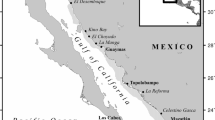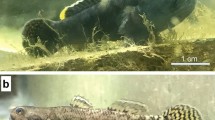Abstract
The study provides the first comprehensive account of the developmental biology of the Indigo barb in captivity. The males develop a reddish hue on the body and margins of their median fins, as opposed to the dull coloration of the females. The fish spawned 6–7 h after administering the breeding hormone, and the fertilized eggs were demersal and adhesive. The larvae hatched 22 h ± 20 min post-fertilization and were demersal with distinctive crawling movements. The yolk sac larvae were 2.48 ± 0.032 mm in total length, with a non-pigmented body and pear-shaped yolk sac. The pre-flexion stage was attained 4 days after hatching, with a single-chambered swim bladder and melanophore aggregation along the body. The larvae reached the flexion stage on day 16, with a body length of 4.54 ± 0.36 mm and the development of caudal fin rays. On the 28th day, the post-flexion stage had produced all of the fins except the pelvics, a two-chambered swim bladder, and a distinctive sub-dorsal blotch. The presence of a supra-anal band and the emergence of scales over the caudal area characterized the juvenile stage. The baseline information on early ontogeny will be valuable for the conservation and sustainable use of the species.






Similar content being viewed by others
Data availability
No datasets were generated or analysed during the current study.
References
Ahamad RM, Basavaraja N (2013) Embryonic and larval development of the olive barb, Puntius sarana sarana (Hamilton, 1822). Isr J Aquac 65:1–9
Andrews C (1990) The ornamental fish trade and fish conservation. J Fish Biol 37:53–59
Arunachalam M (2000) Assemblage structure of stream fishes in the Western Ghats (India). Hydrobiologia 430:1–31. https://doi.org/10.1023/A:1004080829388
Atkore V, Kelkar N, Badiger S, Shanker K, Krishnaswamy J (2020) Multiscale investigation of water chemistry effects on fish guild species richness in regulated and nonregulated Rivers of India’s Western Ghats: implications for restoration. Trans Am Fish Soc 149(3):298–319. https://doi.org/10.1002/tafs.10230
Basheer VS, Abhilash CP, Sibi KK, Krishnan S, Ravi C, Lal KK (2022) A novel method for continuous production of Pehtia setnai, an endemic ornamental barb from the Western Ghats. Abstract. 12th Indian Fisheries and Aquaculture Forum, Chennai, 5–7 May 2022, 115pp
Bhattacharya H, Zhang SC, Wang YJ (2005) Embryonic development of the rosy barb Puntius conchonius Hamilton 1822 (Cyprinidae). Trop Zool 18(1):25–37. https://doi.org/10.1080/03946975.2005.10531212
CEBPOL N (2018) Mainstreaming biodiversity: inland fisheries and aquaculture—a key for food and nutritional security. Centre for Biodiversity Policy and Law, National Biodiversity Authority Chennai.
Chandrasomaw J, Chin HC, Amandakoon HP (1994) Reproductive biology and breeding of Cuming’s barb (Puntius cumingii Gunther). J Appl Ichthyol 10(3):209–214. https://doi.org/10.1111/j.1439-0426.1994.tb00161.x
Chhapgar BF, Sane SR (1992) A new fish of the genus Puntius Hamilton (Ostariophysi: Cyprinidae) from Goa. J Bombay Nat Hist Soc 89(3):357–359
Dahanukar N (2015) Pethia setnai. The IUCN red list of threatened species 2015: e.T172411A70413385. https://doi.org/10.2305/IUCN.UK.2015.RLTS.T172411A70413385.en. Accessed 9 Oct 2023
De Silva SS, Schut J, Kortmulder K (1985) Reproductive biology of six Barbus species indigenous to Sri Lanka. Environ Biol Fishes 12:201–218. https://doi.org/10.1007/BF00005151
Eme J, Mueller CA, Manzon RG, Somers CM, Boreham DR, Wilson JY (2015) Critical windows in embryonic development: shifting incubation temperatures alter heart rate and oxygen consumption of Lake Whitefish (Coregonus clupeaformis) embryos and hatchlings. Comp Biochem Physiol Part A Mol Integr Physiol 179:71–80
Felts RA, Fajits F, Akteruzzaman M (1996) Small indigenous fish species culture in Bangladesh (Technical brief), IFADEP Sub Project 2, Department of Inland Fisheries
Fricke R, Eschmeyer W N, Van der Laan R (eds) (2023) Eschmeyer’s catalog of fishes. https://researcharchive.calacademy.org/research/ichthyology/catalog/fishcatmain.asp. Accessed 20 Sept 2023
Harikumar S (1992) A monographic study of Puntius (Barbus) melanampyx (Day). PhD Thesis, Department of Aquatic Biology and Fisheries, University of Kerala, Trivandrum
Hensen RR, Ploeg A, Fosså SA (2010) Standard names for freshwater fishes in the ornamental aquatic industry. Ornamental Fish International, Maarssen
Islam MR, Yeasmin M, Sadia S, Ali MS, Haque AR, Roy VC (2023) Small Indigenous fish: a potential source of valuable nutrients in the context of Bangladesh. Hydrobiology 2:212–234. https://doi.org/10.3390/hydrobiology2010014
Iyer P, Raghavan R, Dahanukar N, Sood N, Molur S (2016) All that is green does not conserve: green certification of aquarium fishes in India. Curr Sci 110(11):2054–2056
Jacob E (2013) Studies on the captive breeding and reproductive biology of two indigenous ornamental fishes of the Western Ghats. PhD Thesis, Mahatma Gandhi University, Kottayam
Katwate U, Paingankar MS, Jadhav S, Dahanukar N (2013) Phylogenetic position and osteology of Pethia setnai (Chhapgar and Sane, 1992), an endemic barb (Teleostei: Cyprinidae) of the Western Ghats, India, with notes on its distribution and threats. J Threat Taxa 5(17):5214–5227. https://doi.org/10.11609/JoTT.o3857.5214-27
Katwate U, Baby F, Raghavan R, Dahanukar N (2014) The identity of Pethia punctata, a senior synonym of P. muvattupuzhaensis (Teleostei: Cyprinidae). Zootaxa 3884(3):201–221. https://doi.org/10.11646/zootaxa.3884.3.1
Katwate U, Raghavan R, Dahanukar N (2015) The identity of Hamilton’s Ticto Barb, Pethia ticto (Teleostei: Cyprinidae). Zootaxa 3964(4):401–418
Kendall Jr AW, Ahlstrom EH, Moser HG (1984) Early life history stage of fishes and their characters. Ontog Sys Fish 11–22
Kimmel CB, Ballard WW, Kimmel SR, Ullmann B, Schilling TF (1995) Stages of embryonic development of the zebrafish. Dev Dyn 203(3):253–310. https://doi.org/10.1002/aja.1002030302
King TA (2019) Wild caught ornamental fish: a perspective from the UK ornamental aquatic industry on the sustainability of aquatic organisms and livelihoods. J Fish Biol 94(6):925–936
Kottelat M, Lim KK (2021) Two new species of Barbodes from the Malay Peninsula and comments on ‘cryptic species’ in the B. binotatus group (Teleostei: Cyprinidae). Raffles Bull Zool 69(1):522–540. https://doi.org/10.26107/RBZ-2021-0069
Kupren K, Nowosad J, Kucharczyk D (2023) Growth priorities of the four riverine cyprinids during early ontogeny. Animals 13(14):2345. https://doi.org/10.3390/ani13142345
Mahadevi FS, Ahilan B, Rajagopalasamy CBT, Moses TLS (2020) Induced breeding and developmental biology of endemic Western Ghats Fish Dawkinsia filamentosa (Valenciennes, 1844) under captive conditions. Indian J Anim Res 54(9):1069–1077. https://doi.org/10.18805/ijar.B-3874
Maitland PS (1995) The conservation of freshwater fish: past and present experience. Biol Conserv 72(2):259–270
Manoj CK (2010) Genetic characterization controlled breeding and development of transgenic varieties of Puntius denisonii (Day, 1865). PhD Thesis, Kerala Agriculture University, Thrissur
Mariappan P, Antony C, Subramaniam B, Nagarahalli M, Bhosale MM (2021) Successful breeding of the endemic cyprinid fish Dawkinsia rohani in controlled condition—first report. Aquac Res 52(10):4693–4700. https://doi.org/10.1111/are.15303
Mercy TVA, Gopalakrishnan A, Kapoor D, Lakra WS (2007) Ornamental fishes of the Western Ghats of India. National Bureau of Fish Genetic Resources, Kochi
Mercy TA, Sajan S, Malika V (2015) Captive breeding and developmental biology of Sahyadria denisonii (Day 1865) (Cyprinidae), an endangered fish of the Western Ghats, India. Indian J Fish 62(2):19–28
Mohanty BP, Pati MK, Bhattacharjee S, Hajra A, Sharma AP (2013) Small indigenous fishes and their importance in human health. In: Goswami UC (ed) Advances in fish research. Narendra Publishing House, New Delhi, pp 257–278
Molur S, Iyer P, Dahanukar N, Raghavan R (2014) Protected area analysis with respect to freshwater biodiversity and reptile assessments, and development of National Policy for inclusion in legislation (CEPF Project Report). Zoo Outreach Organization, India
Moorhead JA, Zeng C (2010) Development of captive breeding techniques for marine ornamental fish: a review. Rev Fish Sci Aquac 18(4):315–343
Nath JK, Kalita M, Saikia A, Choudhury H, Mukhim DKB, Sarma D (2021) Early embryonic development of the vulnerable Shalyni barb, Pethia shalynius (Yazdani & Talukdar, 1975). J Appl Ichthyol 37(2):268–277. https://doi.org/10.1111/jai.14156
Ng PK, Tan HH (1997) Freshwater fishes of Southeast Asia: potential for the aquarium fish trade and conservation issues. Aquar Sci Conserv 1:79–90
Olivier K (2001) The ornamental fish market, Globefish Research Programme, vol 67. FAO, Rome
Padmakumar KG (2004) Captive breeding for conservation of endemic fishes of Western Ghats. Kerala Agriculture University Vellanikkara, Thrissur
Pal M, Mahapatra BK (2017) Early life history of Indian Ornamental Barb, Puntius sophore (Hamilton, 1822). J Inland Fish Soc India 49(2):10–21
Pethiyagoda R, Meegaskumbura M, Maduwage K (2012) A synopsis of the South Asian fishes referred to Puntius (Pisces: Cyprinidae). Ichthyol Explor Freshw 23(1):69
Ponniah AG, Gopalakrishnan A (2000) Endemic fish diversity of Western Ghats. National Bureau of Fish Genetic Resources, Lucknow
Raghavan R, Dahanukar N, Tlusty MF, Rhyne AL, Kumar KK, Molur S, Rosser AM (2013) Uncovering an obscure trade: threatened freshwater fishes and the aquarium pet markets. Biol Conserv 164:158–169
Ramachandra TV, Setturu B, Vinay S (2018) Carrying capacity of the Netravathi River basin based on the ecological sensitiveness, Sahyadri Conservation Series 74 (Report 136). Environmental Information System, Centre for Ecological Sciences, Bangalore
Rhyne AL, Tlusty MF, Kaufman L (2012) Long-term trends of coral imports into the United States indicate future opportunities for ecosystem and societal benefits. Conserv Lett 5(6):478–485
Sharma L (2023) Life history traits of Pethia punctata (Day, 1865), an endemic fish of Western Ghats. PhD Thesis, Kerala University of Fisheries and Ocean Studies, Kochi
Shirota A (1970) Studies on the mouth size of fish larvae. Jpn Soc Sci of Fish 36:353–369
SriHari M, Gladston Y, Ajina SM, Sreekanth GB, Raghavan R, Jaiswar AK (2019) Demographics of the endemic and threatened small cyprinid Pethia setnai from the Northern Western Ghats, India. Mar Freshw Res 71(7):810–813. https://doi.org/10.1071/MF19122
Sudasinghe H, Ranasinghe T, Herath J, Wijesooriya K, Pethiyagoda R, Rüber L, Meegaskumbura M (2021) Molecular phylogeny and phylogeography of the freshwater-fish genus Pethia (Teleostei: Cyprinidae) in Sri Lanka. BMC Ecol Evol 21(203):1–24
Taki Y, Katsuyama A, Urushido T (1978) Comparative morphology and interspecific relationships of the cyprinid genus Puntius. Jpn J Ichthyol 25(1):1–8
Varadi L, Horvath L (1993) Propagation system of rosy barb, Barbus cocnchonius (L.) for production of stripped gametes. Godollo University of Agricultural Sciences Institute of Animal Husbundary, Hungary
Weber GM, Hostuttler MA (2012) Factors affecting the first cleavage interval and effects of parental generation on tetraploid production in rainbow trout (Oncorhynchus mykiss). Aqua 344:231–238. https://doi.org/10.1016/j.aquaculture.2012.03.017
Wijesekara RGS, Yakupitiyage A (2001) Ornamental fish industry in Sri Lanka: present status and future trends. Aquar Sci Conserv 3:241–252. https://doi.org/10.1023/A:1013154407298
Yadav RB, Muley DB, Patil T, Kudale S (2023) Morphological and chromosomal characterization of Pethia setnai—(Indigo Barb) from Western Ghats of India. J Surv Fish Sci 10(2):151–160
Yazdani GM, Ghate HV (1994) On Puntius setnai Chhapgar and Sane: new reports and comments. J Bombay Nat Hist Soc 91:464–546
Acknowledgements
The authors express their sincere gratitude to the Fisheries and Ports Department, Government of Kerala for funding through the annual plan fund (2022–2023), and to the Director, ICAR–CCARI (Central Coastal Agricultural Research Institute, Goa) for providing the brood stock for conducting the breeding trials. The authors also would like to express deep gratitude to the HoD, Department of Fisheries Resource Management, the Dean, Faculty of Fisheries Science, and to the Director of Research, Kerala University of Fisheries and Ocean Studies, Kochi for the assistance and facilities provided. Special thanks to the staff of the ICAR–CCARI, Goa State Biodiversity Board, Goa State Wetland Authority, Directorate of Fisheries, Govt. of Goa, Fishermen of Valpoi region and the farm staff of KUFOS for assisting in field surveys and breeding programs.
Funding
Funding for the current research work came from the Annual Plan Fund of Fisheries and Ports Department, Government of Kerala (G.O. (Rt) No.595/2022 F & PD dated 22.09.2022) for the year 2022–2023.
Author information
Authors and Affiliations
Contributions
ML and AA have written the main manuscript and documented life history stages and SG, PK, PPG, TM provided the broodstock, edited and reviewed the manuscript.
Corresponding author
Ethics declarations
Conflict of interest
The authors declare that they have no conflict of interest.
Additional information
Publisher's Note
Springer Nature remains neutral with regard to jurisdictional claims in published maps and institutional affiliations.
Rights and permissions
Springer Nature or its licensor (e.g. a society or other partner) holds exclusive rights to this article under a publishing agreement with the author(s) or other rightsholder(s); author self-archiving of the accepted manuscript version of this article is solely governed by the terms of such publishing agreement and applicable law.
About this article
Cite this article
Lal, M., Giri Bhavan, S., Kumar, P. et al. Breeding in captivity for conservation and livelihood: insights into the early ontogeny of the Indigo barb, Pethia setnai (Chhapgar and Sane 1992), a threatened endemic species of the Western Ghats of India. Zoomorphology (2024). https://doi.org/10.1007/s00435-024-00658-3
Received:
Revised:
Accepted:
Published:
DOI: https://doi.org/10.1007/s00435-024-00658-3




